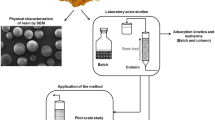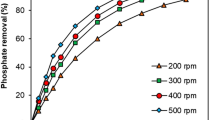Abstract
Removing excessive nitrate from water is essential because it causes eutrophication which in turn has a harmful effect on aquatic life, resulting in a reduction in biodiversity and posing a danger to people’s health when the water is used for drinking. In this study, nitrate removal from aqueous solutions was studied using an ion exchange resin (Purolite A520E) in batch and fixed-bed column experiments. Batch adsorption kinetics was very well described by pseudo-first-order, pseudo-second-order and homogeneous surface diffusion models for resin doses 1.5 and 3.0 g/L at a nitrate concentration 20 mg N/L. Column kinetic data satisfactorily fitted to the empirical Thomas model and a numerical model based on advection–dispersion equation for filtration velocities 2.5 and 5.0 m/h at a column height of 12 cm and inlet concentration 20 mg N/L. The experimental and Thomas model predicted breakthrough adsorption capacity ranges for the two filtration rates were 12.0–13.5 and 8.2–9.7 mg N/g, respectively, whereas the maximum adsorption capacity determined using Langmuir adsorption isotherm model in the batch study was 32.2 mg N/g.




Similar content being viewed by others
References
Ahmad AA, Hameed BH (2010) Fixed bed adsorption of reactive azo dye onto granular activated carbon prepared from waste. J Hazard Mater 175:298–303
Ahmad RT, Nguyen TV, Shim WG, Vigneswaran S, Moon H, Kandasamy J (2012) Effluent organic matter removal by Purolite®A500PS: experimental performance and mathematical model. Sep Purif Technol 98:46–54
Aksu Z, Gonen F (2004) Biosorption of phenol by immobilized activated sludge in a continuous packed bed: prediction of breakthrough curves. Process Biochem 39:599–613
Aliabadi M, Khazaei I, Fakhraee H, Mousavian MTH (2012) Hexavalent chromium removal from aqueous solution by using low-cost biological wastes: equilibrium and kinetic studies. Int J Environ Sci Technol 9:319–326
Awual MR, Urata S, Jyo A, Tamada M, Katakai A (2008) Arsenate removal from water by a weak-base anion exchange fibrous adsorbent. Water Res 42:689–696
Awual MR, Hossain MA, Shenashen MA, Yaita T, Suzuki S, Jyo A (2013) Evaluating of arsenic (V) removal from water by weak-base anion exchange adsorbents. Environ Sci Pollut Res 20:421–430
Bhatnagar A, Sillanpää M (2011) A review of emerging adsorbents for nitrate removal from water. Chem Eng J 168:493–504
Brown PN, Byrne GD, Hindmarsh AC (1989) VODE: a variable coefficient ODE solver. SIAM J Sci Stat Comput 10:1038–1051
Bulgariu L, Ceica A, Lazar L, Cretescu I, Balasanian I (2010) Equilibrium and kinetics study of nitrate removal from water by Purolite A100 resin. Rev Chim 61:1136–1141
Chiu HF, Tsai SS, Yang CY (2007) Nitrate in drinking water and risk of death from bladder cancer: an ecological case–control study in Taiwan. J Toxicol Environ Health 70:1000–1004
Danny DK, Ko KF, Porter JF, McKay G (2001) Film pore diffusion model for the fixed-bed sorption of copper and cadmium ions onto bone char. Water Res 35:3876–3886
Fatima T, Nadeem R, Masood A, Saeed R, Ashraf M (2013) Sorption of lead by chemically modified rice bran. Int J Environ Sci Technol 10:1255–1264
Fewtrell L (2004) Drinking-water nitrate, methemoglobinemia, and global burden of disease: a discussion. Environ Health Perspect 112:1371–1374
Gu B, Ku Y-K, Jardine PM (2004) Sorption and binary exchange of nitrate, sulphate and uranium on an anion-exchange resin. Eniron Sci Technol 38:3184–3188
Guo WS, Shim WG, Vigneswaran S, Ngo HH (2005) Effect of operating parameters in a submerged membrane adsorption hybrid system: experiments and mathematical modelling. J Membr Sci 247:65–67
Hekmatzadeh AA, Karimi-Jashani A, Talebbeydokhti N, Klove B (2012) Modeling of nitrate removal for ion exchange resin in batch and fixed bed experiments. Desalination 284:22–31
Helfferich F (1995) Ion exchange. McGraw-Hill, New York
WHO (2006) Guidelines for drinking-water quality. World Health Organization, Geneva
Ho YS, McKay G (1999) Pseudo-second order model for sorption processes. Process Biochem 34:451–465
Hoek JP, Hoek WF, Klapwijk A (1988) Nitrate removal from ground water—use of a nitrate selective resin and a low concentrated regenerant. Water Air Soil Pollut 37:41–53
Johir MAH, George J, Vigneswaran S, Kandasamy J, Grasmick A (2011) Removal and recovery of nutrients by ion exchange from high rate membrane bio-reactor (MBR) effluent. Desalination 275:197–202
Kapoor A, Viraraghavan T (1997) Nitrate removal from drinking water—review. J Environ Eng 123:371–380
Loganathan P, Vigneswaran S, Kandasamy J, Bolan NS (2014) Removal and recovery of phosphate from water using sorption. Crit Rev Environ Sci Technol. doi:10.1080/10643389.2012.741311
Najm IN (1996) Mathematical modeling of PAC adsorption processes. J Am Water Works Assoc 88:79–89
Nur T, Johir MAH, Loganathan P, Vigneswaran S, Kandasamy J (2012) Effectiveness of purolite A500PS and A520E ion exchange resins on the removal of nitrate and phosphate from synthetic water. Desalin Water Treat 47:50–58
Nur T, Johir MAH, Loganathan P, Nguyen T, Vigneswaran S, Kandasamy J (2014) Phosphate removal from water using an iron oxide impregnated strong base anion exchange resin. J Ind Eng Chem. doi:10.1016/j.jiec.2013.07.009
Orlando US, Baes AU, Nishijima W, Okada M (2002) Preparation of agricultural residue anion exchangers and its nitrate maximum adsorption capacity. Chemosphere 48:1041–1046
Phillips DH, Gu B, Watson DB, Parmele CS (2008) Uranium removal from contaminated groundwater by synthetic resins. Water Res 42:260–268
Pintar A, Batista J, Levec J (2001) Integrated ion exchange/catalytic process for efficient removal of nitrates from drinking water. Chem Eng Sci 56:1551–1559
Primo O, Rivero M, Urtiaga A, Ortiz I (2009) Nitrate removal from electro-oxidized landfill leachate by ion exchange. J Hazard Mater 164:389–393
Purolite (2013) www.purolite.com. Technical data, ISO 9002. Accessed March 2013
Ruthven DM (1984) Principles of adsorption and adsorption processes. Wiley, New York
Samatya S, Kabay N, Yuksel U, Arda M, Yuksel M (2006) Removal of nitrate from aqueous solution by nitrate selective ion-exchange resins. React Funct Polym 66:1206–1214
Sigmaaldrich (2013) www.sigmaaldrich.com. Accessed March 2013
Thomas HC (1944) Heterogeneous ion exchange in a flowing system. J Am Chem Soc 66:1664–1666
Valincius G, Niaura G, Kazakevicˇieneù B, Talaikyteù Z, Kazˇemeù kaiteù M, Butkus E, Razumas V (2004) Anion effect on mediated electron transfer through ferrocene-terminated self-assembled monolayers. Langmuir 20:6631–6638
Verma DK, Hasan SH, Ranjan D, Banik RM (2014) Modified biomass of Phanerochaete chrysosporium immobilized on luffa sponge for biosorption of hexavalent chromium. Int J Environ Sci Technol. doi:10.1007/3/3762-013-0345-6
Villadsen J, Stewart WE (1967) Solution of boundary value problems by orthogonal collocation. Chem Eng Sci 22:1483–1501
Xu X, Gao BY, Yue GY, Zhong QQ (2010) Preparation of agricultural by-product based anion exchanger and its utilization for nitrate and phosphate removal. Bioresour Technol 101:8558–8564
Zagorodni AA (2007) Ion exchange materials properties and applications. Elsevier BV, Amsterdam
Acknowledgments
This work was funded by Australian Research Council Discovery Research Grant (DP 1092603). The authors thank Vitachem for supplying Purolites.
Author information
Authors and Affiliations
Corresponding author
Rights and permissions
About this article
Cite this article
Nur, T., Shim, W.G., Loganathan, P. et al. Nitrate removal using Purolite A520E ion exchange resin: batch and fixed-bed column adsorption modelling. Int. J. Environ. Sci. Technol. 12, 1311–1320 (2015). https://doi.org/10.1007/s13762-014-0510-6
Received:
Revised:
Accepted:
Published:
Issue Date:
DOI: https://doi.org/10.1007/s13762-014-0510-6




